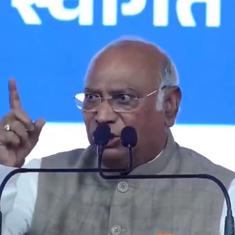On Wednesday, as the Trinamool Congress released its candidate list for the upcoming Lok Sabha election, one statistic stuck out: 41% of them were women.
Party head and West Bengal chief minister Mamata Banerjee made sure to highlight this. “I am so happy,” Banerjee said as she announced the candidates. “This is a proud moment for us. We want to focus on women’s empowerment. We have not restricted ourselves to the minimum of 33% that the government is trying to set for the number of women in Parliament.”
The Trinamool’s move comes against the backdrop of attempts to pass the Women’s Reservation bill, which seeks to reserve a third of the seats in the Lok Sabha for women. Odisha’s Biju Janata Dal has also announced that a third of its party tickets will be reserved for women.
By the women, for the women
While Banerjee referred to the women’s reservation bill, there are differences in how the Trinamool approaches the matter. Unlike any top-down law mandating women’s reservation, the Trinamool’s push to women’s candidates is bottom up, driven by the aggressive role the woman’s vote bank plays in the party’s calculations. Moreover, this policy has roots which go back a few years: in 2014, 35% of the Trinamool’s MPs elected to the Lok Sabha were women.
The Trinamool government over the past eight years has specifically targeted women and girls in its populist policy making.
This is exemplified by the Kanyashree scheme. Similar to a highly-successful programme launched in 1994 by the Bangladesh government, the West Bengal government’s Kanyashree scheme is aimed at preventing child marriage by using cash incentives. Launched in 2013 by the Trinamool government, the project handed out cash to girls between 13 and 18 provided they remained unmarried and in school – thus creating a monetary incentive to prevent child marriage and keep girls from dropping out of school.
Women’s welfare is a vote catcher
The Kanyashree scheme is a success on the ground, with more than 56 lakh beneficiaries as of this month. It also won the United Nations Public Service Award in the Asia-Pacific region for the year 2017.
More interestingly, however, Mamata Banerjee turned the scheme into a major selling point for the Trinamool in the run up to the 2016 Assembly election. August 14 was set aside as “Kanyashree Day” with Trinamool party programmes highlighting the scheme.
Policies targeting girl children is not new in West Bengal. In 2011, the Left Front government had also launched a bicycle distribution scheme specifically targeted at girl students. However, the Left did not place the same emphasis on this in its communication as the Trinamool would with Kanyashree.
Gender identity politics
In 2018, the West Bengal government rolled out another large-scale, populist cash transfer scheme targeted at women voters. Called Rupashree, it proposed marriage assistance for women from economically weaker families. Like Kanyashree, the Rupashree scheme dissuades child marriage since the cash transfer is contingent on the woman being over 18 years.
Adding to these populist schemes is the identity factor of the leader of the Trinamool being a woman herself. As has been noted with both Mamata Banerjee and Tamil Nadu’s Jayalalithaa, women voters seem to connect better with strong female leaders much in the same way as backward caste or minority leaders attract support from their own social groups.
This emphasis on the woman vote bank has been an electoral success for the Trinamool Congress. In 2016, it won massively with more than 70% of the seats in the Assembly. This was driven at least partly by Bengali women – who, data shows, tend to vote for the Trinamool more than Bengali men.
Other states
While the Trinamool might be the most successful party currently, other parties – especially in the south and the east – have also tapped woman voters. As Scroll.in reported in 2018, leaders such as Bihar’s Nitish Kumar, Telengana’s Chandrashekar Rao and Odisha’s Naveen Patnaik do better amongst women then men.
The Women’s Reservation Bill was introduced in Parliament nearly a decade back but was never passed. While most parties have at some point or the other, agreed to it in principal, the measure has never received the actual support required to get it passed either at the Centre or in any state. With no sign of this changing, a move towards female voters organising much in the manner of the caste or religious voting blocs might offer a better chance at political representation.










